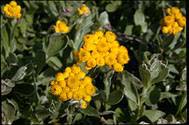

 |
Australian National Botanic Gardens |
 |
A weekly news sheet prepared by a Gardens' volunteer.
Numbers in square brackets [ ] refer to garden bed Sections.
Plants in flower are in bold type.
10 April 2009
 |
Chrysocephalum apiculatum - click for larger image |
This week’s walk is in the Sydney Basin plantings, with a number of plants on the way there.
At the end of the Ellis Rowan building continue straight ahead on the bitumen until you come to Section 31 on your left, where another bitumen road comes in from behind you on your right. A narrow track goes up hill at the [Section 31] sign. At this corner, there are two low shrubs of Spyridium burragorang. This rare species is only found in the Lake Burragorang district near Sydney. It has groups of tiny white flowers surrounded by grey green ‘petals’.
Turn right at the T-junction. On your left is a straggly shrub of the rare Olearia flocktoniana[Section29], with white daisy flowers about 3cm across. At the end of this track is a large patch of Common Everlasting, Chrysocephalum apiculatum [Section 29]. It has small yellow flower groups. Individual plants are up to 50cm tall.
Turn left onto the broader track, then sharp right onto the wide road. There is a bollard in front of you. On your left are two dense large shrubs of Silver Banksia Banksia marginata [Section 28]. They have greeny orange candles 10cm long, which turn yellow when the flowers are fully open. Turn left onto the bitumen road. On your left are two trees of Banksia conferta var. conferta [Section 28]. They have candles about 22cm long, turning from pale green to yellow. Keep an eye out for honeyeaters feeding in the banksias.
Stay left at the fork and keep going up the hill. On your right is a low broad shrub of Correa ‘Pink Lips’ [Section 112] with dusky pink narrow tubular flowers. A few metres on, on the right, is Small Crowea Crowea exalata[Section 112], with pink star flowers.
Turn right onto the Main Path, a cement path with a pebbled surface. You are now entering the Sydney Basin plantings. The patch of tall shrubs full of small white flowers that bees love on your right is Native Blackthorn Bursaria spinosa subsp. spinosa [Section 191s]. On your left is Needle Shaggy Pea Podolobium aciculiferum [Section 191h]. It has prickly leaves with sharp spines at the bases of the leaves, and the occasional yellow pea flower. A little farther on, on your right, are several Calvert’s Heath Epacris calvertiana var. calvertiana[Section 191j], straggly open shrubs with prickly leaves and narrow white tubular flowers.
Turn left onto the tan-bark path. On the right at the corner are several shrubs of Shrubby Platysace Platysace lanceolata [Section 191e] with heads about 5cm across of tiny white flowers. A few metres on, on the right, are several dense shrubs of Soft Geebung Persoonia mollis subsp. leptophylla [Section 191e], withyellow tubular buds opening into four-‘petalled’ flowers. Go straight ahead across the Eucalyptus Lawn and turn left onto the Main Path to get back to the car park.
Betty Wood